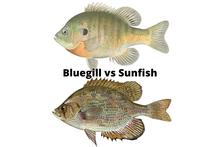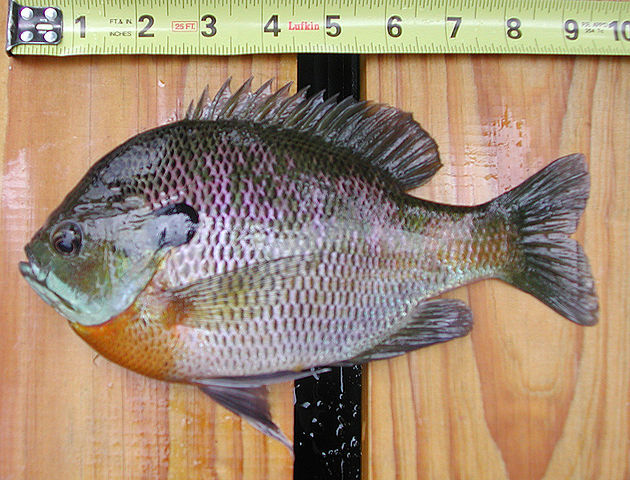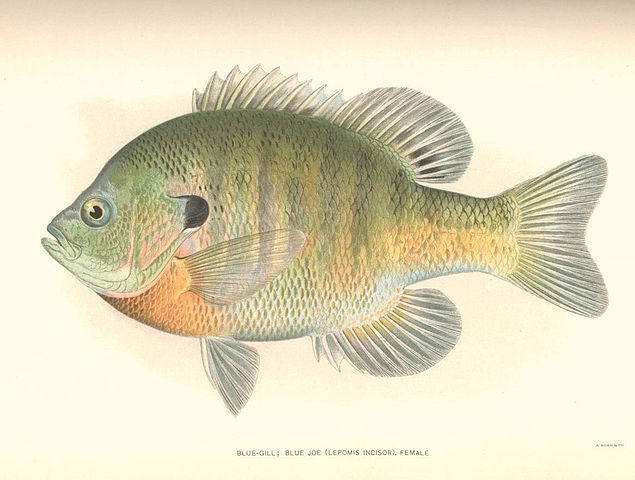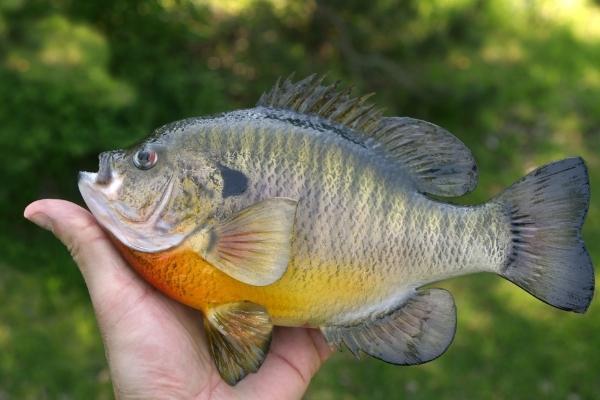This article may contain affiliate links. If you make a purchase after clicking on a link we may earn a small commission at no extra cost to you. As an Amazon Associate, I earn from qualifying purchases.
Bluegill vs Sunfish – What’s the Difference?

Bluegills and sunfish are two small panfish species that are found throughout North America’s freshwater streams, lakes and river systems. Bluegill and sunfish are very often mistaken for one another and even experienced anglers sometimes aren’t able to tell the difference between the two.
In this article, we’ll explore bluegill vs sunfish in more detail and identify some of the key differences in their physical appearance, as well as their behavior and other characteristics.
Bluegill vs Sunfish
The difference between bluegill and sunfish is that all bluegills are sunfish, but not all sunfish are bluegills. A bluegill (Lepomis macrochirus) is a member of the sunfish family (Centrarchidae ). Sunfish are a genus of freshwater fish, and the bluegill is one of its species or varieties.
Bluegills and sunfish are very often important parts of the ecosystems within lakes and rivers where they live as they usually make up a large part of the diet of freshwater predatory fish species that live in these kinds of habitats.

They are smaller than many other types of fish found in freshwater environments, which often makes them an easy target for larger predators, especially when they are in the early life stages up until maturity.
It’s common for even avid anglers to mistakenly assume that bluegills and sunfish are the same species, when in fact, they are two different types of fish.
They do, however, belong to the Centrarchidae family of fish, which consists of more than 30 different varieties of panfish and other small species found throughout freshwater lakes and rivers.
Also Read: Shellcracker vs Bluegill
There is also confusion as to the group that the bluegill and sunfish belong to within their Centrarchidae family. A bluegill is considered to be a variation of sunfish, but sunfish are not considered to be of the bluegill species.
There are, in fact, many different fish within the Centrarchidae family that are considered to be a variation of sunfish as it is one of the more popular types of freshwater fish found throughout North America.
What is a Bluegill?
The bluegill is a freshwater fish that is also known as “bream,” “brim,” “sunny,” “copper nose,” or “perch” in Texas. It belongs to the sunfish family Centrarchidae, which is part of the order Perciformes. It is indigenous to North America and may be found in streams, rivers, lakes, and ponds.

Bluegill are one of the more popular varieties of sunfish species found throughout North America’s freshwater lakes and river systems.
Also Read: Best Time of Day to Catch Bluegill
These fish make up a large portion of the diet of a wide range of different species from walleye and muskies to largemouth bass.
They are voracious predators in their own right as bluegills are commonly known to eat anything they find within their habitat.
Known to scientists as Lepomis macrochirus, bluegill are one of more than 30 species of sunfish that are native to North America.
Their native habitat range consists of much of the southeastern United States, as well as the Midwest and all of the tributaries, lakes and other waterways that are connected to the Mississippi River system.
Anglers often refer to bluegill as coppernose, bream or other names depending on the geographical region they are found in. In the last 100 years, bluegill have been introduced to various waterways across the western United States and New England where they often thrive in states like California thanks to the warm climate.
There are a few of the various sunfish species that very closely resemble bluegill, making it difficult for even accomplished anglers to tell the difference between bluegill vs sunfish and other species in many cases.
What is a Sunfish?
Sunfish (Centrarchidae) are a family of freshwater ray-finned fish in the order Perciformes. The centrarchid family has 38 fish species, 34 of which still exist, and includes several fish species such as rock bass, largemouth bass, bluegill, pumpkinseed, green sunfish, and crappies.
Only North America is home to all of the species in the family.
Most of the confusion revolving around the bluegill vs sunfish debate is understanding the distinction between sunfish and bluegill. While all bream or bluegill are sunfish, not all sunfish are technically going to be bluegill.

This is because sunfish are not a particular type of species, but are instead a family of panfish that includes a plethora of different types of freshwater fish. Bluegill are classified within the Sunfish family, but there are a select few panfish species within the Sunfish distinction that share traits and characteristics with the bluegill species.
Virtually all the different types of bass species—including largemouth, smallmouth, and others—as well as crappie, pumpkinseed, and many other fish that are similar are within the Sunfish family. Certain species like bass and crappie are very easy to distinguish from bluegill, but others are not.
In the following sections, we will cover some of the more frequently-occurring freshwater sunfish that can be found throughout North America.
We’ll focus on three different sunfish species that are most often confused with bluegill, as well as some of the distinctive traits and identification factors you can use to tell bluegill apart from their fellow sunfish.
Longear Sunfish
One of the most common species of sunfish that are found in habitats alongside bluegill and other types of freshwater panfish include the longear sunfish. This fish shares many characteristics and features with the bluegill, making it one that is probably confused with bluegill more than any other variety of sunfish.
A longear sunfish’s body is marked with the same distinct dark, vertical stripes that bluegill have on either side of their bodies. They are found in large numbers throughout much of the eastern United States around the southeastern rivers and tributaries, as well as many of the small lakes and larger reservoirs around this area.
Longear sunfish are also known to live around the Great Lakes and throughout the Mississippi River system as far north as Minnesota and as far south as Louisiana.
Their body has a very bulky and robust appearance, much like the bluegill, as the front portion of the fish’s body from the dorsal fin to the nose is more rounded and has a similar profile to the bluegill.
These fish are capable of growing to about 9 inches when they reach full maturity and commonly weigh in around 14 ounces to 1 pound.
Redear Sunfish
Many anglers are somewhat well-acquainted with the redear sunfish, but this is another species that is very often mistaken for bluegill. In lakes, rivers and ponds where bluegill are usually found, you can usually expect to find some other type of native sunfish to the area.
Redear sunfish are probably one of the more prevalent species found alongside bluegill throughout the southeastern United States and up into the Midwest.
Their body shape and size is very similar to that of a bluegill, but one of the more distinct markings that makes it easy to tell the bluegill vs sunfish apart—at least in this case—is the fish’s bright red coloration around its ‘ear.’
This small, but clear difference is in direct contrast to the bluegill’s sky-blue coloration along its lower gill portion behind the fish’s ‘ear.’
Redear sunfish very often have a darker coloration along their backs and sides compared to bluegill, but it’s sometimes very difficult to tell whether a fish is a redear sunfish or a bluegill when it’s in the water.
Only when the fish has been caught and landed can you get an up-close look at the coloration and tell whether it’s a bluegill vs sunfish.
Green Sunfish
Many anglers agree that the green sunfish often appears to be virtually identical to the bluegill in many ways. It’s tough to tell whether you’re looking at a green sunfish or a bluegill when viewing the fish as they are in their natural habitat, but on the rare occasion that you can compare the bluegill vs green sunfish side-by-side, you can see the main differences.
The green sunfish will have a much more vivid green coloration along the edges of the fish’s gills, fins and tail while the bluegill’s color appears to be more yellow. One of the most common ways to tell these fish apart from bluegill is to look for the dark black ‘ear’ as the bluegill will lack this particular feature.
How to Identify a Bluegill or a Sunfish
A bluegill will always have the classic panfish profile and appearance, but there are some specific ways you can tell a bluegill vs sunfish apart using some of the distinct characteristics of the bluegill species. Bluegills always have a long dorsal fin that runs along the length of the fish’s back.
They also have a smaller mouth than some of the other sunfish species, but the mouth is often roughly the same size as most types of sunfish.
Bluegill will have a dark spot on the fish’s ‘ear’ that might not be as profound as some sunfish species, but still noticeable to anglers and those viewing the fish. When the bluegill is a juvenile, the fish’s lower jaw and belly underneath the pectoral fin will be relatively the same color as the rest of its body.
However, as the bluegill matures and grows larger, this area will begin to have a bright orange coloration that is in direct contrast from the blue color that’s found around the fish’s gills.
All bluegill will have distinct vertical lines running along the side of the fish’s body. In some cases, these stripes or lines might appear to be darker than others, but they should be somewhat visible to the angler, especially in sunlight.
Conclusion
Being able to tell the difference between a bluegill vs sunfish requires a good understanding of bluegill and at least the ability to point out certain differences between sunfish and bluegill. By using the information in this article, you should have a basic understanding of the differences between bluegill and sunfish for your next fishing trip.
